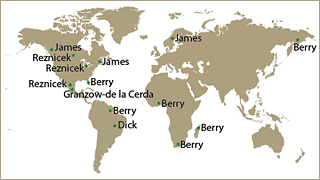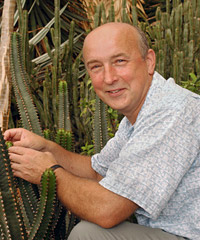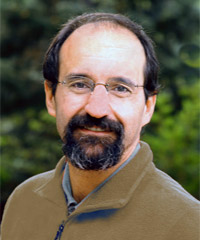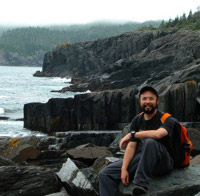Home // UM Museums // Curators in the Field // Herbarium
Curators in the Field
Herbarium

Paul E. Berry
Ph.D., Washington University, 1980
Director and Curator of Vascular Plants, University of Michigan Herbarium; Professor, Ecology and Evolutionary Biology

My research focuses on plant systematics, including floristics, molecular phylogenetics, phytogeography, and bioinformatics. My work has mainly focused on the Neotropics, particularly the Guayana Shield, the Andes, and Brazil, as well as the upper midwestern United States. Plant groups of special interest are Euphorbiaceae (Euphorbia and Croton), Fuchsia (Onagraceae), and Rapateaceae. I am particularly interested in the study of "giant genera," those that are considered to contain over 500 species and have often been avoided because of their complex taxonomy, geography, and large numbers.
My newest research project stems from my interest in Euphorbiaceae, giant genera, and international collaborations. I am the Principal Investigator on a new National Science Foundation award in the "PBI" program (Planetary Biodiversity Inventories). The project is called "EuphORBia: a global inventory of the spurges," and it aims to produce a worldwide virtual monograph of the genus by 2012, using modern bioinformatic tools, traditional field work and taxonomy, molecular phylogenetics, and floral developmental studies. Euphorbia contains over 2000 species and is distributed worldwide, but is most prominent in Africa, where many cactus-like succulents have evolved. We wish to make this a highly collaborative project, with training of students, postdocs, and participation of colleagues on all the vegetated continents. Over the past two years, I have done field work in Madagascar, South Africa, Jamaica, Siberia, Colombia, and various parts of the U.S. (Florida, Colorado, Wyoming, Utah) as part of the PBI project.
Íñigo Granzow-de la Cerda
Ph.D., Universidad de Barcelona
Assistant Curator (Bryophytes); Lecturer in Ecology and Evolutionary Biology

Dr. Íñigo Granzow-de la Cerda is Assistant Curator of Bryophytes in the University of Michigan Herbarium, whose research interests include bioinformatics, bryophyte ecology and systematic. His current NSF funded project uses OCR (optical character recognition) technology using digital images to develop a method to catalog herbarium specimens that maximizes efficiency. The resulting on-line catalog will add over 100,000 specimens from Mexico and Central America to a searchable herbarium catalog, and includes a mapping application and specimen photos. There are currently 83,000 specimens online from a previous NSF-funded project at the Herbarium, including corresponding label images and a mapping application. The project is a collaboration between the U-M Herbarium (Granzow de la Cerda and Stuart Lindsay), Yale's Peabody Museum, México's Comisión Nacional para el Conocimiento y Uso de la Biodiversidad, and The University of Kansas Biodiversity Research Center.
Christopher W. Dick
Ph.D., Harvard University
Assistant Curator (Vascular Plants); Assistant Professor, Ecology and Evolutionary Biology

Dr. Christopher W. Dick received his PhD from Harvard University. His fields of study include tropical ecology and evolution, population genetics, biogeography, and forest history.
I am interested in historical and evolutionary processes that underlie the rich diversity of tree species in tropical forests. My current research is focused on (1) population genetic structure and comparative phylogeography of widespread neotropical tree species, (2) measuring pollen and seed dispersal at local scales using genetic markers, and (3) using phylogenies and fossil records to understand the biogeographic history of tropical rainforest tree communities. My research is funded by the National Science Foundation (DEB 0640379) and by a collaborative grant from the European Union (SeedSource project).
My molecular ecology lab is active with graduate students doing independent research. Shalene Jha studies the effects of pollinator shifts on the maintenance of genetic diversity in reproductively-specialized native trees in shade coffee farms in Mexico. Jess Peirson is analyzing the post-glacial phylogeography of goldenrods (Solidago simplex species group) across North America. Sandra Yap is examining the comparative phylogeography of rainforest trees in the Philippine archipelago. Roosevelt García studies comparative phylogeography of the fig/fig-wasp mutualism in Peru and Panama. Diego Alvarado studies mechanisms of diversification of mammals in the Ecuadorian Andes. Brian Sedio is using community phylogenies to dissect the roles of ecology and biogeographic history in the assembly of tropical forest tree communities.
Timothy James
Ph.D., Duke University, 2003
Assistant Curator (Fungi); Assistant Professor, Ecology and Evolutionary Biology

My fields of study include the evolution of fungi, mating systems, and phylogenetics. Much of the obvious adaptive evolution in Fungi is observed in their diversification of mating systems and dispersal mechanisms. I study the evolution of sex and reproductive traits of Fungi and attempt to link these traits with phylogeny and population genetics. I am particularly interested in the intriguing phenomenon of heterokaryosis in Fungi. The heterokaryon is an alternative to diploidy in which multiple genetically different nuclei inhabit the same cell after mating occurs. I am studying genomic conflict in this system by measuring the degree to which the nuclei of a heterokaryon compete or cooperate with each other. Understanding this behavior includes investigating the role of pheromone signaling in the communication between nuclei.
In addition, our lab is interested in the evolution of the ancient aquatic fungi known as the chytrids. Our methodology includes molecular biology, phylogenetics, and fungal cultivation. Currently I am focusing on the following three projects:
- Evolution of mating systems and nuclear behavior in mushroom fungi (Agaricomycetes)
- Molecular systematics of ancient fungal lineages
- Evolutionary genomics and population genetics of the chytrid fungal disease of amphibians
Anton A. Reznicek
Ph.D., University of Toronto
Assistant Director, Curator of Vascular Plants

Dr. Reznicek's research interests include systematics and evolution of Cyperaceae, especially Carex, with emphasis on a multi-level approach concentrating on several aspects including development of new characters useful in systematics, monographic studies of major groups, sectional classification and nomenclature, and processes and patterns of evolution. A major present focus is the neotropics, especially Mexico.
Dr. Reznicek is also interested in phytogeography of the northeastern North American flora, concentrating on the Great Lakes region. His primary interests here are plant migration and colonization, origin and persistence of relict plant species and communities, and wetland vegetation dynamics, especially of the Great Lakes shorelines.

